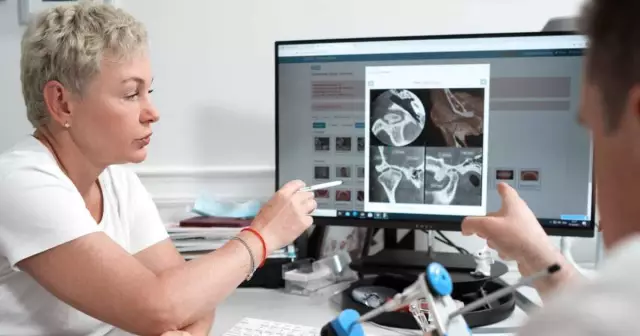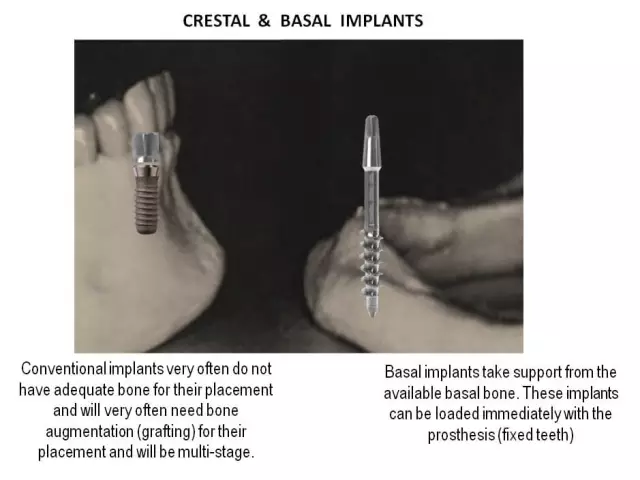- Author Rachel Wainwright [email protected].
- Public 2023-12-15 07:39.
- Last modified 2025-11-02 20:14.
All-on-4 implantation in the absence of teeth
The content of the article:
- Advantages of All-on-4 implantation
- The main stages of implantation All-on-4
- How long will all stages of implantation take?
- Service life of implants and prostheses
The complete absence of teeth is a serious problem, and not only an aesthetic one. It is possible to restore a beautiful smile and chewing function in the absence of teeth in different ways: much depends on the data of the medical examination and the financial capabilities of the patient himself. There are removable acrylic or clasp dentures: they are relatively inexpensive, but they have a lot of inconveniences. In most patients, their presence in the mouth causes a gag reflex or allergic reactions; the prosthesis itself is rather fragile and quickly deteriorates. Removable dentures are poorly fixed in the oral cavity and constantly interfere, thereby causing certain difficulties in speaking and eating.

A worthy alternative to removable dentures is the installation of conditionally removable or fixed implant-supported dentures. Modern implantation protocols do not imply highly traumatic interventions and pain. The risks of allergic reactions and complications are reduced to zero if all stages are performed correctly.
The most popular method of jaw prosthetics on implants is considered to be "All-on-4" implantation. For extreme bone atrophy in the upper jaw, it is best to choose zygomatic implantation.
Advantages of All-on-4 implantation
Various implantation techniques have a number of similar advantages over other dental restoration options:
- reliability and durability;
- high-quality restoration of chewing function;
- aesthetics of a smile;
- absence of diction disorders, which is often observed when wearing removable dentures;
- excellent fixation of the prosthesis;
- no discomfort: artificial teeth are perceived by the patient as real;
- prevention of diseases of the gastrointestinal tract;
- prevention of the development of bone atrophy.
The main stages of implantation All-on-4
Regardless of the chosen implantation protocol, there are several stages of treatment:
- Preparation and diagnostics. This stage includes the consultation of a specialist, conducting surveys. The patient donates blood, undergoes computed tomography of the jaw, 3D modeling technologies are used. With their help, the implantologist can choose the best place for implantation, see the smallest features of the jaw structure that can affect the outcome of the operation. Based on the diagnostic results, the doctor selects a suitable implant model. Also, during the examination, relative and absolute contraindications to implantation can be identified. Some of them can be eliminated - for example, to cure caries, to bring chronic diseases into remission.
- The operation of installing implants. The technique of implanting titanium rods is now as gentle as possible; if possible, doctors avoid gum incisions by performing a small puncture. Most of the protocols assume immediate loading of the temporary prosthesis to restore esthetic and chewing function.
- Installation of a permanent prosthesis. After the final engraftment of the screws, the temporary construction is changed to a permanent prosthesis. It differs from the temporary one in its high strength, comfort and stability. Permanent dentures are usually made of cermets or zirconia.
How long will all stages of implantation take?
Each patient is unique. Much depends on the initial state of dental health, the volume of bone tissue, and the regenerative abilities of the body. The rate of engraftment of implants is influenced by concomitant pathologies, the immune status of a person. The operation itself for installing implants usually takes 1.5-3 hours (depending on the selected protocol, the need for preliminary tooth extraction). Fixation of the temporary prosthesis is carried out immediately, or within 1-3 days after the operation.
When relative contraindications are identified at the first stage, the treatment period is delayed until all deviations are eliminated. There are fewer and fewer absolute contraindications for implantation. For example, some protocols are applicable to patients with diabetes mellitus, although implantation was previously prohibited for them.
Service life of implants and prostheses
The temporary prosthesis is designed for a short service life: from 6 months to 1.5 years. Immediately after the implants are firmly fixed in the bone, the temporary prosthesis should be replaced with a permanent one. It is made according to an individual impression, therefore, all anatomical features of the jaw are taken into account. The service life of a permanent prosthesis is 10 years or more, subject to all medical recommendations for care.
In order to prolong the success of implantation for several decades, it is necessary:
- Carefully monitor the hygiene of teeth and gums. Dentures, just like real teeth, require regular cleaning.
- Eat properly. It is not recommended to heavily load the implants, especially during the first time after their installation. You cannot gnaw nuts, use your teeth as scissors.
- To refuse from bad habits. Smoking and alcohol adversely affect the condition of the oral mucosa, exacerbating the course of periodontal disease and periodontitis.
- Carefully choose a clinic and a specialist for implantation, as well as high-quality materials (implants, prostheses).
- Visit your dentist periodically for a follow-up examination.
Found a mistake in the text? Select it and press Ctrl + Enter.






